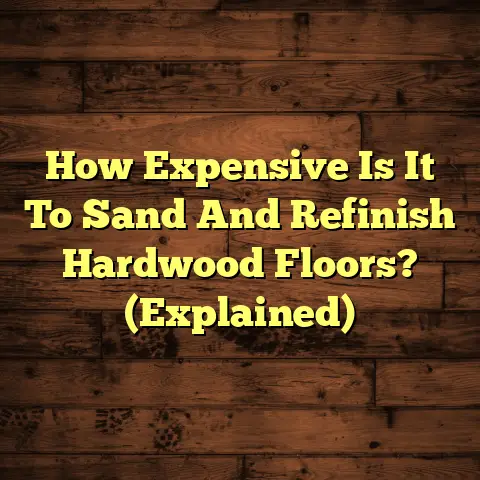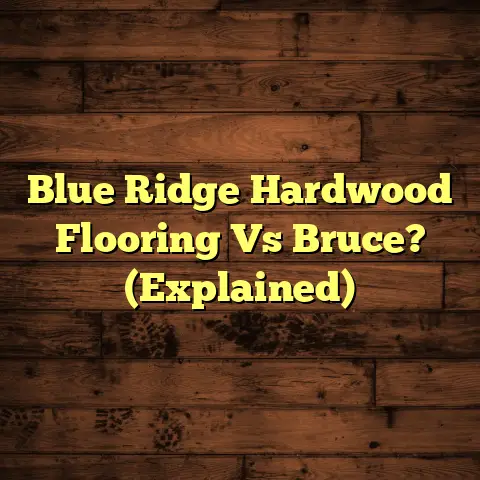Can You Glue Vinyl Plank? (2 Adhesion Blunders!)
Would you rather struggle with peeling vinyl planks that disrupt your beautiful floors or spend hours trying to fix a botched installation due to poor adhesion?
Let’s dive into the world of vinyl plank flooring and discover whether glue is the answer to your flooring woes or a recipe for disaster.
Vinyl plank flooring has exploded in popularity, and for good reason. It’s durable, looks fantastic, and can be relatively easy to install.
But the question of whether to glue it down often comes up.
Many homeowners and DIY enthusiasts assume gluing is a straightforward solution, but trust me, it’s not always the best approach.
In this article, I’ll break down everything you need to know about gluing vinyl plank flooring.
I’ll cover the pros and cons, the types of adhesives, and the critical mistakes to avoid.
Consider this your guide to achieving a flawless, long-lasting vinyl plank floor.
Section 1: Understanding Vinyl Plank Flooring
What is Vinyl Plank Flooring?
Vinyl plank flooring is a resilient flooring option designed to mimic the look of hardwood or stone.
It’s made from synthetic materials, primarily PVC (polyvinyl chloride), giving it excellent durability and water resistance.
There are several types of vinyl plank flooring, including:
-
Luxury Vinyl Tile (LVT): Offers the highest realism and often comes in thicker planks.
-
Rigid Core Vinyl Plank (SPC/WPC): Features a rigid core for added stability and impact resistance.
-
Standard Vinyl Plank: A thinner, more flexible option suitable for smoother subfloors.
One of the biggest advantages of vinyl plank is its versatility.
It can be used in almost any room of the house, including kitchens, bathrooms, and basements.
It’s also more forgiving than hardwood when it comes to moisture and temperature fluctuations.
Installation Methods
Vinyl plank flooring can be installed in a few different ways:
-
Floating: Planks connect to each other using a click-lock system, without being adhered to the subfloor.
-
Glue-Down: Planks are glued directly to the subfloor using an adhesive.
-
Peel-and-Stick: Planks have a pre-applied adhesive backing for easy installation.
The choice of installation method depends on several factors, including the type of vinyl plank, the condition of the subfloor, and the intended use of the space.
So, when would you choose to glue down vinyl planks?
Generally, gluing is recommended for:
-
High-Traffic Areas: Glue provides extra stability and prevents planks from shifting under heavy use.
-
Uneven Subfloors: Glue can help bridge minor imperfections in the subfloor.
-
Commercial Settings: Glue-down installations are often preferred for their durability and longevity in commercial spaces.
Section 2: The Case for Gluing Vinyl Planks
Advantages of Gluing Vinyl Planks
Gluing vinyl planks offers several key benefits, particularly in specific situations.
One major advantage is increased stability.
In areas with heavy foot traffic, glued-down planks are less likely to shift or separate over time compared to floating floors.
This can significantly extend the lifespan of your flooring.
Another benefit is improved sound insulation.
Gluing can help dampen noise and reduce vibrations, making your space quieter and more comfortable.
Plus, if you have an uneven subfloor, gluing can provide a more uniform surface.
The adhesive fills in minor imperfections, creating a smoother, more stable base for your flooring.
However, gluing isn’t always the best choice.
It’s more labor-intensive than floating installations and can be more difficult to remove if you ever decide to replace the flooring.
Types of Adhesives
Choosing the right adhesive is crucial for a successful glue-down vinyl plank installation.
Here are some common types of adhesives:
-
Pressure-Sensitive Adhesives: These adhesives form a bond when pressure is applied. They’re easy to use but may not be suitable for all types of vinyl plank.
-
Trowel-Applied Adhesives: These adhesives are applied with a notched trowel, creating a ribbed pattern that provides a strong bond. They’re ideal for larger installations and uneven subfloors.
-
Peel-and-Stick Adhesives: These adhesives come pre-applied to the vinyl planks, making installation quick and easy. However, the bond strength may not be as strong as with other types of adhesives.
It’s essential to choose an adhesive that is specifically designed for vinyl plank flooring.
Using the wrong adhesive can lead to a host of problems, including:
-
Warping: The adhesive may not properly adhere to the planks, causing them to warp or buckle.
-
Bubbling: Air pockets can form between the adhesive and the planks, creating unsightly bubbles.
-
Planks Lifting: The adhesive may fail to hold the planks in place, causing them to lift or separate.
Always check the manufacturer’s recommendations to ensure you’re using the right adhesive for your specific type of vinyl plank.
Section 3: The Two Adhesion Blunders
Blunder #1: Using the Wrong Type of Adhesive
This is where things can go south really fast.
Using the wrong adhesive can lead to a whole host of problems.
Imagine spending hours installing your new vinyl plank floor, only to find that the planks are lifting or bubbling within a few weeks.
I’ve seen it happen, and it’s not pretty.
One common mistake is using a general-purpose adhesive instead of one specifically designed for vinyl plank.
These adhesives may not have the right chemical properties to bond properly with the PVC material, leading to adhesion failure.
Another mistake is using an adhesive that is not compatible with the subfloor material.
For example, some adhesives may not bond well with concrete or plywood.
This can result in the planks lifting or shifting over time.
Here’s a table summarizing common adhesive mistakes and their consequences:
| Adhesive Mistake | Consequence |
|---|---|
| Using general-purpose adhesive | Poor adhesion, planks lifting |
| Incompatible with subfloor material | Planks shifting, bond failure |
| Expired adhesive | Weak bond, adhesive breakdown |
| Applying too much or too little adhesive | Uneven adhesion, bubbling, plank movement |
To avoid this blunder, always read the adhesive manufacturer’s instructions carefully.
Make sure the adhesive is specifically designed for vinyl plank flooring and is compatible with your subfloor material.
Don’t skimp on quality – invest in a high-quality adhesive that is known for its strong bond and long-lasting performance.
Blunder #2: Inadequate Surface Preparation
Proper surface preparation is absolutely critical for a successful glue-down vinyl plank installation.
I can’t stress this enough.
Even the best adhesive won’t work if the subfloor is not properly prepared.
One of the most common pitfalls is neglecting to clean the subfloor thoroughly.
Dust, dirt, and debris can prevent the adhesive from bonding properly, leading to adhesion failure.
Another mistake is failing to level the subfloor.
Uneven surfaces can create air pockets between the adhesive and the planks, causing them to bubble or lift.
Skipping moisture testing is another big no-no.
Excess moisture in the subfloor can weaken the adhesive bond and lead to mold growth and other problems.
The long-term implications of poor surface preparation can be significant.
Not only will your vinyl plank floor look bad, but it can also be costly to repair or replace.
Here’s a list of essential surface preparation steps:
-
Clean the Subfloor: Remove all dust, dirt, and debris using a vacuum or broom.
-
Level the Subfloor: Use a self-leveling compound to fill in any cracks or uneven areas.
-
Moisture Test: Check the moisture level of the subfloor using a moisture meter.
-
Prime the Subfloor: Apply a primer to improve adhesion and prevent moisture from seeping into the adhesive.
By taking the time to properly prepare the subfloor, you’ll ensure a strong, long-lasting bond between the adhesive and the vinyl planks.
Section 4: Best Practices for Gluing Vinyl Planks
Choosing the Right Adhesive
As I mentioned earlier, selecting the right adhesive is paramount.
But how do you know which one to choose?
Start by considering the type of vinyl plank you’re using.
Different types of vinyl plank may require different types of adhesives.
For example, rigid core vinyl plank may require a more flexible adhesive to accommodate its dimensional stability.
Next, consider the specific installation conditions.
Is the subfloor concrete or wood?
Is the area prone to moisture?
These factors can influence your choice of adhesive.
Always refer to the manufacturer’s recommendations for guidance.
They will typically specify which types of adhesives are best suited for their products.
Don’t be afraid to ask questions.
Consult with a flooring professional or adhesive supplier to get expert advice on choosing the right adhesive for your project.
Preparing the Subfloor
I cannot emphasize this enough.
Proper subfloor preparation is the foundation of a successful glue-down vinyl plank installation.
Here’s a step-by-step guide:
-
Inspect the Subfloor: Check for any cracks, uneven areas, or signs of moisture damage.
-
Clean the Subfloor: Remove all dust, dirt, and debris using a vacuum or broom.
-
Level the Subfloor: Use a self-leveling compound to fill in any cracks or uneven areas. Allow the compound to dry completely before proceeding.
-
Moisture Test: Check the moisture level of the subfloor using a moisture meter. The moisture level should be within the acceptable range specified by the adhesive manufacturer.
-
Prime the Subfloor: Apply a primer to improve adhesion and prevent moisture from seeping into the adhesive. Allow the primer to dry completely before proceeding.
Here are some additional tips for preparing the subfloor:
-
Remove any old flooring or adhesive residue.
-
Repair any damaged areas of the subfloor.
-
Ensure the subfloor is structurally sound and stable.
Application Techniques
Applying the adhesive correctly is just as important as choosing the right adhesive and preparing the subfloor.
Follow these steps for a successful application:
-
Read the Adhesive Manufacturer’s Instructions: This is crucial. Each adhesive may have specific application instructions that must be followed.
-
Apply the Adhesive with a Notched Trowel: Use a notched trowel to spread the adhesive evenly over the subfloor. The size and shape of the notches will depend on the type of adhesive and the manufacturer’s recommendations.
-
Work in Small Sections: Apply the adhesive to a small section of the subfloor at a time. This will prevent the adhesive from drying out before you can install the vinyl planks.
-
Install the Vinyl Planks: Carefully place the vinyl planks onto the adhesive, ensuring they are properly aligned and seated.
-
Roll the Vinyl Planks: Use a flooring roller to press the vinyl planks firmly into the adhesive. This will ensure a strong bond and remove any air pockets.
Here are some additional tips for applying the adhesive:
-
Avoid applying too much adhesive. This can create a mess and make it difficult to install the vinyl planks.
-
Avoid applying too little adhesive. This can result in a weak bond and cause the planks to lift or shift.
-
Follow the adhesive manufacturer’s recommended open time. This is the amount of time you have to install the vinyl planks after applying the adhesive.
Section 5: Dealing with Adhesion Issues
Identifying Common Adhesion Problems
Even with the best preparation and techniques, adhesion problems can still occur.
Here are some common signs of poor adhesion:
-
Planks Lifting: This is the most obvious sign of adhesion failure. The planks may lift at the edges or in the middle.
-
Gapping: Gaps may appear between the planks, indicating that they are not properly bonded to the subfloor.
-
Curling: The edges of the planks may curl up, indicating that the adhesive is not holding them down properly.
-
Bubbling: Air pockets may form between the adhesive and the planks, creating unsightly bubbles.
These problems can be caused by a variety of factors, including:
-
Using the wrong adhesive.
-
Inadequate surface preparation.
-
Improper adhesive application.
-
Moisture problems.
Solutions for Adhesion Problems
Fortunately, many adhesion problems can be fixed.
Here are some solutions for common adhesion issues:
-
Planks Lifting: If the planks are lifting, you may be able to re-glue them using a high-quality vinyl plank adhesive. Clean the subfloor and the back of the plank thoroughly before applying the adhesive.
-
Gapping: If gaps have appeared between the planks, you may be able to fill them with a color-matched caulk or sealant.
-
Curling: If the edges of the planks are curling up, you may be able to flatten them using a heat gun and a roller. Be careful not to overheat the planks, as this can damage them.
-
Bubbling: If air pockets have formed between the adhesive and the planks, you may be able to puncture the bubbles and press the planks back down.
When to Consult a Professional
In some cases, adhesion problems may be too severe to fix yourself.
If you’re not comfortable tackling the repairs yourself, or if the problems are widespread, it’s best to consult with a flooring professional.
A professional can assess the situation and recommend the best course of action.
They may be able to repair the existing flooring, or they may recommend replacing it altogether.
Conclusion
Recap the Importance of Proper Adhesion
Gluing vinyl plank flooring can be a great option for certain situations.
It provides extra stability, improves sound insulation, and can help bridge minor imperfections in the subfloor.
However, it’s essential to do it right.
Using the wrong adhesive or failing to prepare the subfloor properly can lead to a host of problems, including planks lifting, gapping, curling, and bubbling.
By following the best practices outlined in this article, you can ensure a successful glue-down vinyl plank installation that will last for years to come.
Final Thoughts
Deciding whether to glue down vinyl planks is a big decision.
Consider your specific needs and circumstances carefully.
If you’re installing vinyl plank in a high-traffic area or on an uneven subfloor, gluing may be the best option.
Just remember to choose the right adhesive, prepare the subfloor properly, and apply the adhesive correctly.
With a little bit of knowledge and effort, you can achieve a beautiful, long-lasting vinyl plank floor that you’ll be proud of for years to come.





